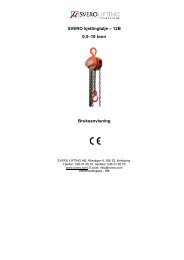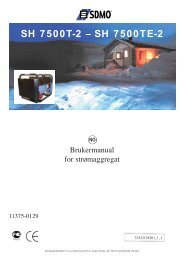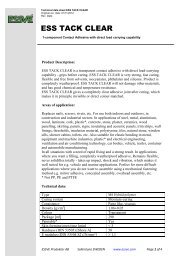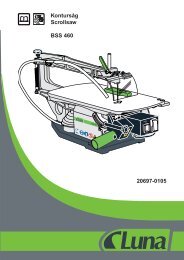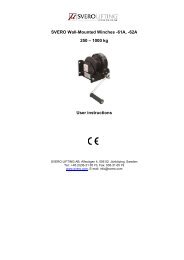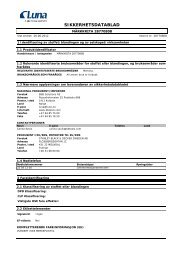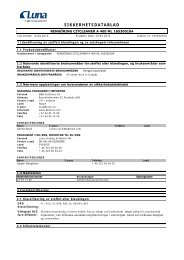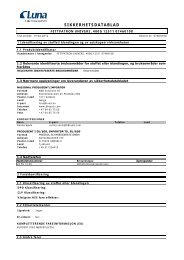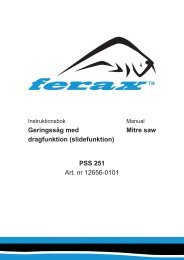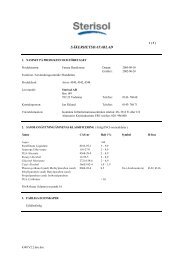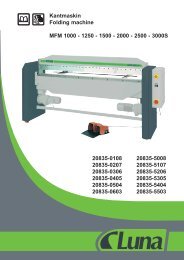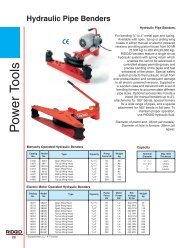Instruction manual BPT260S-BPT310S-BPT410S - Luna Norge AS
Instruction manual BPT260S-BPT310S-BPT410S - Luna Norge AS
Instruction manual BPT260S-BPT310S-BPT410S - Luna Norge AS
You also want an ePaper? Increase the reach of your titles
YUMPU automatically turns print PDFs into web optimized ePapers that Google loves.
Fig. 5<br />
Support long work pieces (longer than jointer tables) with helping roller<br />
stands or table extensions.<br />
Planing the face of a work piece up to 75mm thick:<br />
Place the work piece against the jointer fence. Adjust the cutter block<br />
guard to the height of the work piece. When guiding the work piece, the<br />
hands slide over the cutter block guard (Fig 6)<br />
Fig. 6<br />
Planing the edge of a work piece (jointing) or planning work pieces<br />
more than 75mm thick:<br />
Place the work piece against the jointer fence. Adapt the cutter block<br />
guard to the width of the work piece (Fig 7).<br />
Fig. 7<br />
Chamfering a work piece:<br />
Place the work piece against the jointer fence. Adapt the cutter block guard<br />
to the width of the work piece (Fig 8).<br />
Planing of narrow work pieces:<br />
Add an auxiliary fence to safely guide narrow workpieces (see Fig 9).<br />
Fig. 8<br />
25<br />
Fig. 9<br />
Operating notes:<br />
The planer tables are precisely aligned ex. works. They may only be loaded<br />
when the table-cabinet locks are engaged, otherwise they may be damaged<br />
or precision of machine be lost. Always use sharp cutter knives!<br />
Check work piece for foreign objects (nails, screws) and for loose knots.<br />
Feed with thicker work piece end at the front, hollow side downward.<br />
Plane the stock with the grain, if possible. You get a better surface when<br />
planing several passes with less chip removal. Switch machine off if no<br />
further planing is to be done immediately afterwards. Cover the cutter<br />
block with the cutter block guard. Jointing and planing of short workpieces<br />
may only be performed with the help of tailor made push woods and<br />
templates.<br />
For the authorized use of the machine observe the appendix A “safe<br />
operation“ (on the last pages of this operating <strong>manual</strong>)<br />
A1: Planing, stock thickness below 75mm<br />
A2: Edge jointing<br />
A3: Planing of narrow gibs<br />
A4: Planing of short stock with push wood.<br />
5.2 Thicknessing<br />
Correct operating position:<br />
To feed the work piece into the machine, position yourselves offset to one<br />
side of the feed opening.<br />
Work piece handling<br />
Adjust the planer table to the work piece thickness. Feed work piece<br />
slowly and straight into the thicknesser. It will then be automatically fed<br />
through the thicknesser. Guide work piece straight through the thicknesser.<br />
To remove the work piece from the machine, position yourselves offset to<br />
one side of the outfeed opening. Support long work pieces with helping<br />
roller stands.<br />
Operating notes:<br />
Always use sharp cutter knives! Feed with thicker work piece end at the<br />
front, hollow side downward. Max. 4,5 mm depth of cut. If a work piece<br />
gets stuck lower the planer table by app. 1mm (1/4 crank turn). Plane the<br />
stock with the grain, if possible. You get a better surface when planing several<br />
passes with less chip removal. Switch machine off if no further planning<br />
is to be done immediately afterwards. Work pieces shorter than<br />
150mm may not be processed. Machine max. 2 work pieces at one time.<br />
Feed on both outer sides.<br />
6. SETUP AND ADJUSTMENTS<br />
General note:<br />
Setup and adjustment work may only be carried out after the machine is<br />
protected against accidental starting. Pull the mains plug!<br />
6.1 Changing cutterblock knives<br />
The given instructions about knifeinstallation, maximum knife circle, minimum<br />
knife clamping width and correct knife lock blot tightening torque<br />
must strictly be observed. The cutter knives may only be changed when<br />
the mains plug is pulled! Risk of personal injury by cuts from the cutter<br />
knives. Wear suitable gloves when changing cutter knives. Move cutter<br />
block cover to front and fence to back. Turn the four square-hear bolts of<br />
the cutter knife lock bar all the way in (wear gloves!). At first remove cutter<br />
knife, then cutter knife lock bar from the cutter block. Clean all surfaces<br />
of cutter block and cutter knife lock bar with a suitable solvent (do not<br />
use cleaning agents that could corrode the light metal components). Use<br />
only suitable cutter knives conforming the technical specification and EN<br />
847-1. Unsuitable, incorrectly mounted, dull, cracked of bent cutter knives<br />
can work loose or increase the risk of kickback considerably. Always replace<br />
all three cutter knives at once. The cutter knife lock bars are balanced<br />
to each other and thus can randomly be placed. Only cutter knives<br />
marked “HSS” or “HS” can be resharpened! When resharpening, remove<br />
the same amount of material from all three cutter knives, otherwise a balancing<br />
error may cause damage to the bearings.



